Saludos estimados amigos de la plataforma Hive, sean todos bienvenidos una vez más a mi blog. El siguiente artículo va dirigido a una pequeña familia de lepidópteros que posee poca distribución en el mundo, mostrando como ejemplo a una de sus especies pertenecientes al género Calephelis.
Greetings dear friends of the Hive platform, welcome once again to my blog. The following article is directed to a small family of Lepidoptera that has little distribution in the world, showing as an example one of its species belonging to the genus Calephelis.
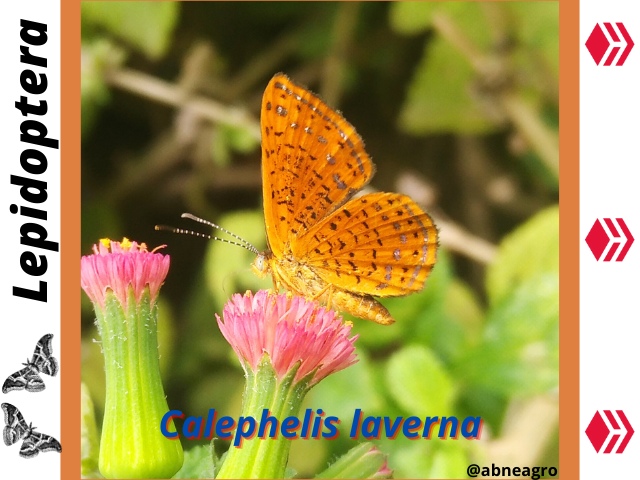
La gran diversidad que está presente en la clase Insecta es realmente fascinante, estos seres vivos han poblado el planeta durante millones de años sin interrupciones; tiempo en el que han ido evolucionando para poder adaptarse a diferentes entornos, siendo más eficientes y prósperos en climas cálidos, aspecto que es debido por ser invertebrados de sangre fría, por lo que requieren del calor para poder subsistir.
Las mariposas forman parte de aquellos insectos que son admirados y apreciados por las personas, siendo consideradas como buen presagio en algunas culturas o como seres que traen mala fortuna en el caso de los lepidópteros nocturnos; no obstante, todo el proceso de desarrollo de estos artrópodos es realmente increíble, pues, el gran cambio que sufren durante un complejo proceso llamado metamorfosis es una de las obras más llamativas que encontramos en la naturaleza, por este motivo, la metamorfosis es considerada como un renacimiento por muchos.
The great diversity that is present in the class Insecta is really fascinating, these living beings have populated the planet for millions of years without interruption; time in which they have evolved to adapt to different environments, being more efficient and prosperous in warm climates, aspect that is due to be cold-blooded invertebrates, so they require heat to subsist.
Butterflies are part of those insects that are admired and appreciated by people, being considered as a good omen in some cultures or as beings that bring bad fortune in the case of nocturnal lepidoptera; however, the whole process of development of these arthropods is really incredible, because, the great change they undergo during a complex process called metamorphosis is one of the most striking works we find in nature, for this reason, metamorphosis is considered as a rebirth by many.
.png)
En la actualidad ya no es un secreto que estos insectos son de los más numerosos que hay en el mundo, ya que han poblado de manera exitosa gran parte de nuestro planeta, exceptuando aquellos climas en donde el frío es extremo. Dentro de las más de 160.000 especies que existen dentro del orden Lepidoptera encontramos a la superfamilia Papilionoidea, taxón que alberga a las famosas mariposas colas de golondrina (papilionidae); sin embargo, esta no es la única familia que compone a la ya mencionada superfamilia, ya que también existe un pequeño grupo de mariposas conocidas comúnmente como mariposas marca de metal, estos ejemplares forman parte de una familia conocida científicamente como Riodinidae, la cual posee a las siguientes subfamilias: Nemeobiinae, Rionididae y Euselasiinae.
It is no longer a secret that these insects are among the most numerous in the world, as they have successfully populated a large part of our planet, except for those climates where the cold is extreme. Among the more than 160. 000 species that exist within the order Lepidoptera we find the superfamily Papilionoidea, taxon that houses the famous swallowtails butterflies (papilionidae); however, this is not the only family that makes up the aforementioned superfamily, as there is also a small group of butterflies commonly known as metal mark butterflies, these specimens are part of a family known scientifically as Riodinidae, which has the following subfamilies: Nemeobiinae, Rionididae and Euselasiinae.
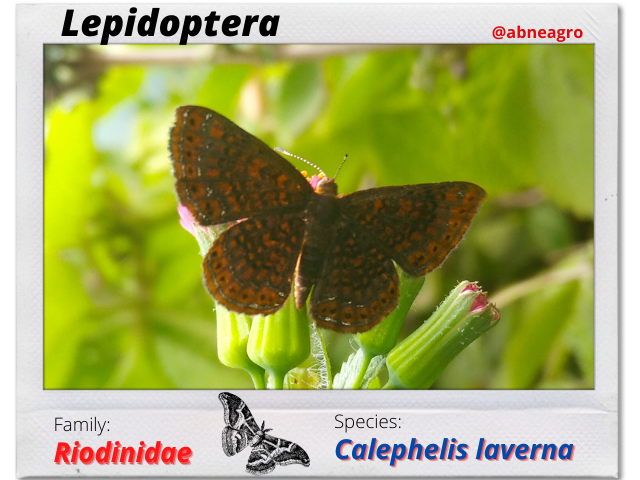.png)
Dentro de la subfamilia Rionididae se ubica el género Calephelis, el cual posee un estimado de 40 especies identificadas. Debido a que son un grupo bastante pequeño y con muy poca distribución geográfica, ha hecho que sean ignoradas dentro del campo investigativo, generando esto que exista muy poca información referente a la vida de estos ejemplares de lepidóptero; no obstante, existen datos que las hacen muy únicas dentro del numeroso orden del que forman parte a nivel taxonómico.
Las mariposas que forman parte de este género se caracterizan por ser muy coloridas, presentando muy pocas colores poco llamativos como el marrón o el negro, algunas poseen mucha similitud en sus diseños, por lo que puede ser un poco complicado identificar a ciertas especies, tal es el caso de la Calephelis schausi y la que se presenta en esta publicación Calephelis laverna, por lo que hay que observar detalladamente cada uno de los coloridos detalles que presentan a lo largo de sus cuerpos para poder diferenciar a estas especies correctamente.
Within the subfamily Rionididae is the genus Calephelis, which has an estimated 40 identified species. Being a fairly small group with very little geographical distribution, they have been ignored in the field of research, generating very little information about the life of these lepidopteran specimens; however, there are data that make them very unique within the large order of which they are part at the taxonomic level.
The butterflies that are part of this genus are characterized by being very colorful, presenting very few inconspicuous colors such as brown or black, some have much similarity in their designs, so it can be a bit complicated to identify certain species, such is the case of Calephelis schausi and the one presented in this publication Calephelis laverna, so you have to observe in detail each of the details of their colorful bodies to correctly differentiate these species.
.png)
La especie Calephelis laverna presenta un predominante color naranja en todo su cuerpo, incluyendo las 3 regiones que componen su cuerpo (cabeza, tórax y abdomen). De igual manera, sus alas tienen diversos patrones negros y grisáceos, siendo los más llamativos dos hileras de color metálico que recorren tanto las alas anteriores como las posteriores, debido a este peculiar patrón de colores son conocidas como mariposas marca de metal.
La coloración naranja se hace más visible en la parte baja de sus alas, lugar en el que presentan menos patrones de otro color. Es importante acotar que, las delicadas alas de las mariposas son membranas transparentes, pero estas están cubiertas por miles de escamas que son capaces de reflejar la luz y por esta razón adquieren una tonalidad que es captada por nuestros ojos. Por otra parte, sus antenas son alargadas y presentan anillos blancos que dividen cada segmento, su principal función es del tipo sensorial.
The species Calephelis laverna has a predominant orange color throughout its body, including the 3 regions that make up its body (head, thorax and abdomen). Similarly, its wings have various black and grayish patterns, the most striking being two rows of metallic color that run along both the anterior and posterior wings, due to this peculiar color pattern they are known as metal mark butterflies.
The orange coloration is more visible in the lower part of their wings, where they present fewer patterns of another color. It is important to note that, the delicate wings of butterflies are transparent membranes, but these are covered by thousands of scales that are able to reflect light and for this reason they acquire a hue that is captured by our eyes. On the other hand, their antennae are elongated and have white rings that divide each segment, their main function is sensory.
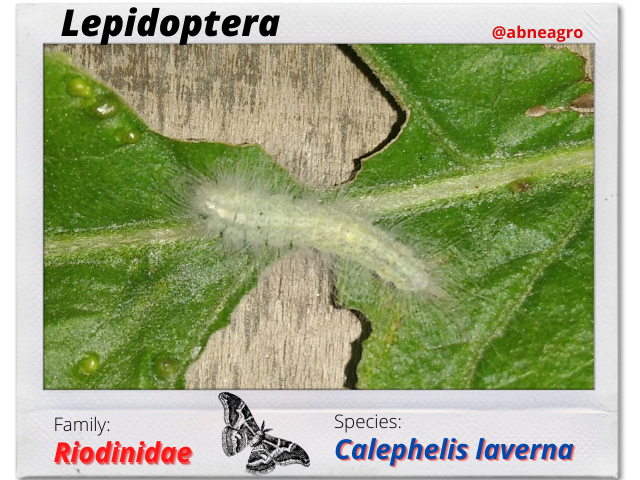.png)
Durante sus primeras etapas de vida (larva) se alimenta de tejidos vegetales, generalmente no se suelen encontrar muchas orugas sobre las plantas, por lo que no se les considera especies plaga y además, son poco frecuentes en plantas de interés agrícola. Las orugas suelen ser verdes, pero sus cuerpos están recubiertos por una muy fina capa de pubescencia, lo que las hace parecer blancas. Durante estas etapas son completamente inofensivas para el humano y como dato curioso, estas pequeñas orugas se han adaptado para convivir con hormigas (mirmecofilia), lo que quiere decir que a pesar de no poseer un mecanismo de defensa confiable, utilizan a las hormigas para mantener alejados a los depredadores, para ello secretan sustancias azucaradas que extraen de las plantas con la finalidad de aportar una fuente energética a estos himenópteros, a cambio las hormigas les brindan protección, algo muy similar se puede apreciar entre las colonias de áfidos y otros hemípteros junto con las hormigas.
During their first stages of life (larvae) they feed on plant tissues. Generally, not many caterpillars are found on plants, so they are not considered pest species and they are not very frequent on plants of agricultural interest. The caterpillars are usually green, but their bodies are covered with a very thin layer of pubescence, which makes them appear white. During these stages this lepidopteran species is completely harmless to humans and as a curious fact, these small caterpillars have adapted to coexist with ants (myrmecophilia), which means that despite not possessing a reliable defense mechanism, they use ants to keep predators away, For this purpose, these eruciform insects secrete sugary substances that they extract from plants in order to provide an energy source to these hymenopterans, in return the ants provide protection, something very similar can be seen among colonies of aphids and other hemiptera along with ants.
.png)
En sus etapas juveniles, estos lepidópteros presentan un aparato bucal mandibulado, el cual emplean para cortar y destruir los tejidos vegetales de las hojas, por este motivo muchas orugas son consideras plagas terribles dentro de los cultivos, ya que cuando sus poblaciones son muy elevadas pueden arrasar con plantaciones enteras, generando innumerables perdidas económicas. En las fotografías se puede apreciar parte del daño generado por esta pequeña oruga sobre una planta.
In their juvenile stages, these lepidoptera have a jawed mouthparts, which they use to cut and destroy the plant tissues of the leaves, for this reason many caterpillars are considered terrible pests in crops, because when their populations are very high they can wipe out entire plantations, generating innumerable economic losses. The photographs show part of the damage caused by this small caterpillar on a plant.
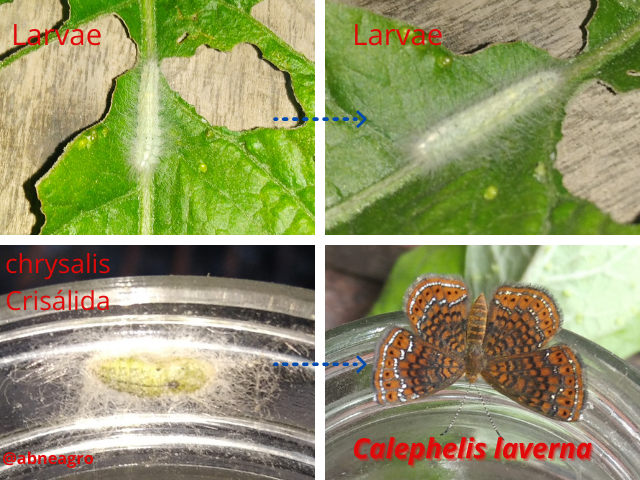.png)
Los lepidópteros presentan una metamorfosis completa, lo que quiere decir que su desarrollo pasa por diferentes etapas, empezando siendo un huevo, posteriormente eclosiona una oruga que ira aumentando su tamaño a medida que se alimenta, mudando tan solo parte de la cutícula que recubre su cabeza, ya que el resto de su cuerpo es completamente blando. Pasado un tiempo la oruga realizará una crisálida de la que emergerá una hermosa mariposa en todo su esplendor.
Lepidoptera present a complete metamorphosis, which means that their development goes through different stages, starting as an egg, then hatching a caterpillar that will increase its size as it feeds, molting only part of the cuticle that covers its head, since the rest of its body is completely soft. After a while the caterpillar will make a chrysalis from which a beautiful butterfly will emerge in all its splendor.
.png)
Cuando una mariposa emerge de una crisálida no puede volar, por lo que requiere de algunos minutos para poder distribuir su sangre (hemolinfa) hacia sus alas, posteriormente puede alzar vuelo sin problemas. Durante este proceso es completamente vulnerable, por lo que la falta de espacio o el ataque de algún depredador puede dañar algunas de sus alas evitando esto que la hemolinfa se distribuya correctamente y condenando al lepidóptero a una muerte segura.
When a butterfly emerges from a chrysalis it cannot fly, so it requires a few minutes to distribute its blood (hemolymph) to its wings, after which it can take flight without problems. During this process it is completely vulnerable, so the lack of space or the attack of a predator can damage some of its wings, preventing the hemolymph from being distributed correctly and condemning the lepidopteran to certain death.
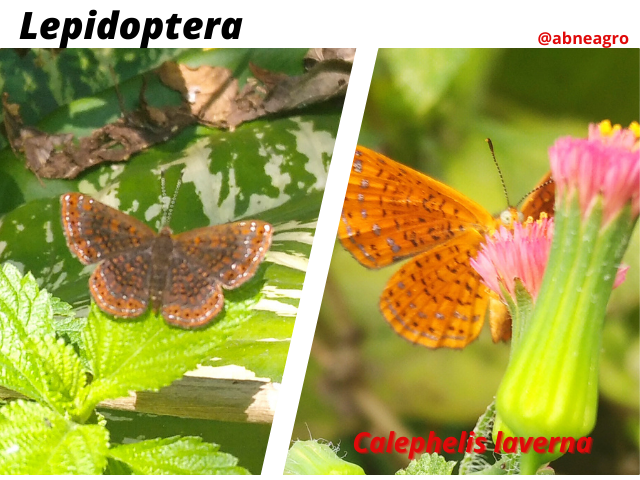.png)
La especie Calephelis laverna es una pequeña mariposa con colores realmente hermosos, esta coloración la hace muy llamativa, claramente esta coloración ayuda a mantener a alejados a depredadores, aún así, muchos organismos tanto vertebrados o invertebrados las utilizan como fuente de alimento, de manera que, siempre debe usar las herramientas que la evolución les otorgo para poder sobrevivir en los siempre difíciles entornos naturales.
The species Calephelis laverna is a small butterfly with really beautiful colors, this coloration makes it very striking, clearly this coloration helps it to ward off predators, even so, many organisms both vertebrates and invertebrates use them as a food source, so, they must always know how to use the tools that evolution gave them to survive in the always difficult natural spaces.

El siguiente artículo se realizó con la finalidad de dar a conocer datos relevantes sobre la familia Riodinidae, específicamente sobre una de sus especies como lo es la Calephelis laverna. Todos los lepidópteros son necesarios dentro de los ecosistemas, ya que sus constantes contribuciones ayudan a mantener un correcto funcionamiento de los ecosistemas terrestres, por lo que el cuidado de estas especies es necesario para que podamos seguir apreciando la vida en nuestro planeta.
The following article was written with the purpose of providing relevant data about the family Riodinidae, specifically about one of its species such as Calephelis laverna. All Lepidoptera are necessary in ecosystems, since their constant contributions help to maintain the proper functioning of terrestrial ecosystems, so the care of these species is necessary so that we can continue to appreciate life on our planet.

Todas las fotografías presentadas en esta publicación pertenecen al autor @abneagro, las fotos fueron realizadas con un dispositivo móvil Redmi 8A y editadas con la aplicación Canva.
All photos presented in this publication belong to the author @abneagro, the photos were taken with a Redmi 8A mobile device and edited with the Canva application.

Some references:

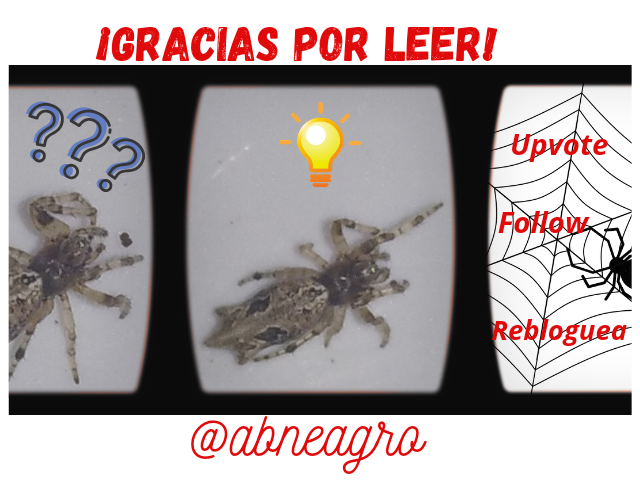
Oh vaya! Que hermoso ejemplar lograste captar... Me encanta la fotografia con sus alas extendidas :) y cuanta informacion agregas muy bien lobo!! Jejeje
Y al parecer ese amuleto es muy bueno, mira nomás que bien te ha ido jajaja me alegra mucho que seas bien recompensado por tus extraodinarias publicaciones...
Saludos lobo feroz!!! :D
Muchas gracias por el apoyo Salticidae jeje, pues si, eran mariposas que tenía en cautividad para desarrollarlas, al momento que las Liberé me regalaron poses para las fotos jajaja, un abrazoo Lourdes!
Es una hermosa especie. No la tengo dentro de mi colección pero el tipo de escamas y coloración m resulta conocida. Me parece haberla visto en el grupo de lepidoptero más pequeños, creo que ésta que nos compartes es mediana?
Tuviste suerte de conseguirla con sus alas extendidas. Es una belleza, me fascina!!! 😆
Bienvenida nuevamente a mi blog profesora Belkis. Este lepidóptero es algo popular en nuestro país, su tamaño es pequeño, es más o menos del tamaño de una difunta moneda de 5bs con sus alas extendidas, por lo que no llega a ser microlepidóptero. Por otro lado, todas las fotos en diversos ángulos pude obtenerlas debido a que era una de las mariposas que prácticamente crié, al momento de liberarlas posaron para la cámara jajaja.
Congratulations @abneagro! You have completed the following achievement on the Hive blockchain and have been rewarded with new badge(s) :
Your next target is to reach 18000 upvotes.
You can view your badges on your board and compare yourself to others in the Ranking
If you no longer want to receive notifications, reply to this comment with the word
STOPTo support your work, I also upvoted your post!
Gracias por lo recordatorios, saludos!
Su post ha sido valorado por @ramonycajal
Muchas gracias por el apoyo amigos, saludos!
Thanks for your contribution to the STEMsocial community. Feel free to join us on discord to get to know the rest of us!
Please consider supporting our funding proposal, approving our witness (@stem.witness) or delegating to the @stemsocial account (for some ROI).
Please consider using the STEMsocial app app and including @stemsocial as a beneficiary to get a stronger support.
Thanks for the support!
Your content has been voted as a part of Encouragement program. Keep up the good work!
Use Ecency daily to boost your growth on platform!
Support Ecency
Vote for Proposal
Delegate HP and earn more
Thanks for the support!
Congratulations, your post has been upvoted by @dsc-r2cornell, which is the curating account for @R2cornell's Discord Community.
Thanks for the support!
We appreciate your work and your post has been manually curated on behalf of Insects Of The World Community. It will be added to the weekly curation report. Keep up the good work
great jog
We appreciate your work and your post was manually curated by @none! from the DNA team!
Reach us on Discord to learn more about the project!